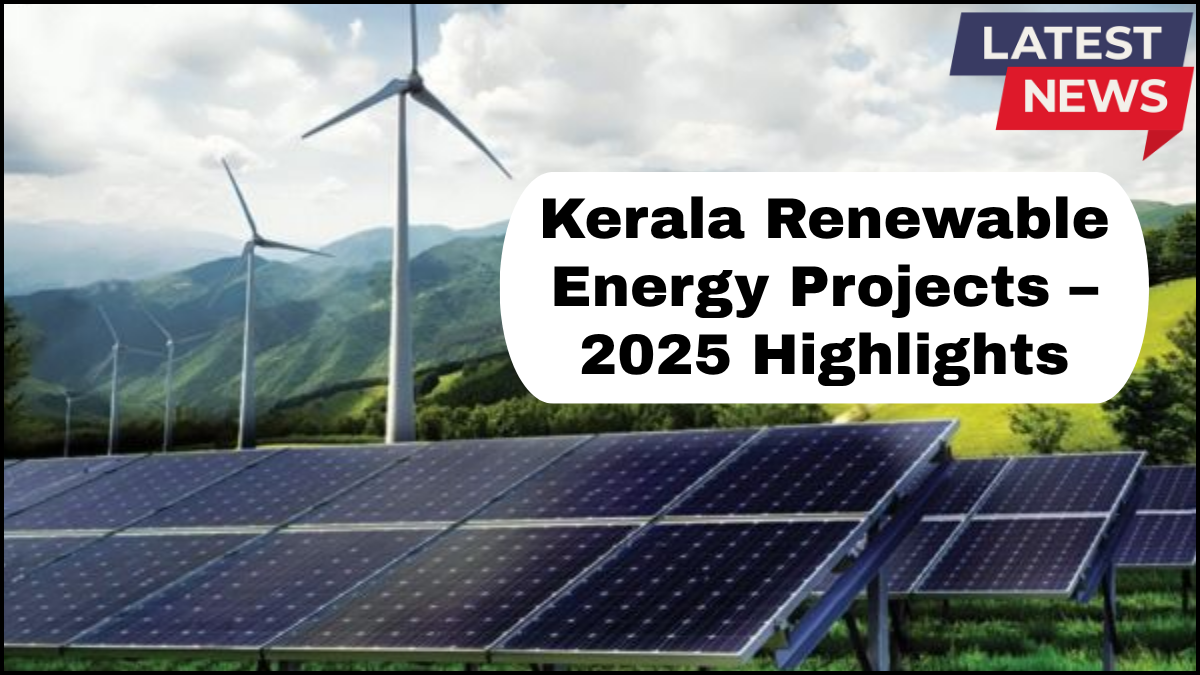Kerala is accelerating its shift toward clean energy, and 2025 marks a pivotal year for the state’s renewable energy landscape. With a strong push from the government and public sector undertakings, the focus is now on scaling solar and wind infrastructure to meet energy demands sustainably. Here’s a comprehensive look at the Kerala Renewable Energy Projects 2025, highlighting key initiatives, performance metrics, and future plans.

Kerala’s Renewable Energy Vision
Kerala aims to become energy self-sufficient by maximizing its renewable energy portfolio. The state’s 2025 agenda aligns with India’s larger climate goals, focusing on reducing dependence on fossil fuels and enhancing grid reliability through clean energy sources. The Kerala Renewable Energy Projects 2025 serve as a roadmap toward achieving this vision.
Key Solar Projects in 2025
Solar power remains the backbone of Kerala’s renewable energy strategy due to the state’s high solar insolation and availability of non-agricultural land for installations. Several solar projects have either been commissioned or are underway in 2025:
1. Kasaragod Solar Park Expansion
Originally developed by SECI and implemented through the NTPC, the Kasaragod Solar Park has been expanded to a total capacity of 200 MW in 2025. The project now features advanced bifacial panels, allowing for more efficient energy generation on overcast days.
2. Rooftop Solar Initiatives Across Urban Areas
Under the Soura Program led by KSEB (Kerala State Electricity Board), over 150,000 households and 5,000 commercial buildings now operate rooftop solar installations. This initiative is expected to contribute 300 MW to the state grid by the end of the year.
3. Floating Solar Plants on Reservoirs
Kerala, with its dense network of dams and water bodies, has moved aggressively into floating solar. The Banasurasagar Floating Solar Plant, now operational, generates 14 MW and represents a scalable model for similar deployments in other districts.
Wind Energy Projects Scaling Up
While solar has dominated the scene, wind energy is gaining momentum in Kerala’s hilly districts and coastal belts. New data from 2025 shows significant capacity additions:
1. Palakkad Wind Corridor Development
Palakkad district, known for its wind potential, has been targeted for a 120 MW wind farm developed in collaboration with private sector firms. The project is part of a hybrid energy strategy that includes solar-wind integration for stable power output.
2. Offshore Wind Feasibility Study
The Kerala State Industrial Development Corporation (KSIDC) is conducting an extensive feasibility study for offshore wind projects along the Arabian Sea coastline. If viable, these projects could add a projected 500 MW over the next five years, starting with initial pilot installations in 2026.
Grid Integration and Energy Storage Advances
One of the significant challenges of renewable energy is its intermittent nature. In 2025, Kerala has made substantial progress in smart grid systems and energy storage:
-
Battery Storage Integration: KSEB has rolled out a 50 MW battery storage project in Thrissur, designed to stabilize solar output during peak hours.
-
Smart Metering Systems: Over 2 million smart meters have been installed to better manage distributed energy resources and give consumers real-time access to consumption data.
Policy and Investment Support
Kerala’s 2025 policy framework actively supports renewable growth:
-
Green Tariffs introduced for consumers opting for 100% renewable power.
-
Incentives for Solar and Wind Developers, including land lease concessions, faster clearances, and subsidized connectivity charges.
-
International Partnerships: Kerala has collaborated with European firms for technology transfer in solar panel efficiency and wind turbine design.
Community-Based Energy Models
Another unique highlight of Kerala Renewable Energy Projects 2025 is the focus on community participation:
-
Energy Cooperatives have been launched in rural areas to manage mini-grid solar projects, promoting decentralized ownership.
-
Women-led Solar Maintenance Units have been established, providing employment and technical training to local women in districts like Wayanad and Idukki.
Environmental and Economic Impact
By mid-2025, Kerala’s renewable energy projects have resulted in:
-
Reduction of over 1.8 million tons of CO₂ emissions annually.
-
Creation of 15,000+ green jobs, spanning from engineering to maintenance.
-
Significant drop in power outages, especially in remote and tribal regions.
The Road Ahead
Kerala’s ambitious targets don’t stop at 2025. Plans are in motion to integrate Artificial Intelligence for grid forecasting, build hydrogen production units powered by renewables, and increase public-private partnerships to expand the state’s clean energy footprint even further.
FAQs
Q1: What are the major Kerala Renewable Energy Projects in 2025?
A: Key projects include the expansion of Kasaragod Solar Park, Banasurasagar Floating Solar Plant, rooftop solar installations under the Soura Program, and the Palakkad Wind Corridor.
Q2: How is Kerala using wind energy in 2025?
A: Wind projects like the Palakkad Wind Farm and offshore wind feasibility studies are adding capacity, with hybrid models integrating wind and solar for grid stability.
Q3: What incentives are available for renewable energy developers in Kerala?
A: Developers receive benefits like fast-track clearances, reduced connectivity fees, and subsidies under state energy policies.
Q4: Are there any community-based renewable energy projects in Kerala?
A: Yes, energy cooperatives and women-led solar service units are helping decentralize power generation and create local jobs.
Q5: How much renewable energy does Kerala plan to generate by 2025?
A: Kerala aims to generate over 2,500 MW from renewable sources, with solar contributing the bulk, supported by wind and small hydro initiatives.
click here to learn more
